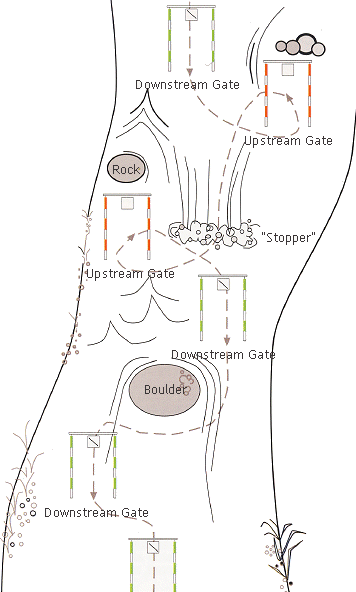What is Canoe Slalom?
Imagine a water sport that combines the precision of skiing with the excitement of whitewater rafting. That’s slalom paddling for you! It’s one of the most spectacular paddlesports out there, and it’s gaining popularity in the UK.
Slalom paddling is like an obstacle course on water. Paddlers race down a river, navigating through a series of gates hung above the water which have to be done going downstream or upstream. The goal? To be as fast and accurate as possible. It’s a test of skill, stamina, and technique that’ll keep you on the edge of your seat.
How Does a Slalom Race Work?
Here’s the lowdown:
- Paddlers race one at a time against the clock.
- They must go through a number of gates in a specific order.
- Each competitor gets two runs, and their best run counts.
- Time penalties are given for touching or missing gates.
The aim is to be fast and clean – easier said than done when you’re battling rushing water!
Who Can Compete?
There are five classes in slalom paddling:
- Men’s and Women’s Kayak (K1)
- Men’s and Women’s Canoe (C1)
- Canoe Doubles (C2)
Whether you prefer to paddle solo or with a partner, there’s a category for you.
What is Kayak Cross
Kayak Cross is the adrenaline-pumping cousin of slalom. If you think slalom paddling sounds exciting, wait until you hear about kayak cross.
In kayak cross, four paddlers race head-to-head down a course. They start by launching off a ramp (yes, you read that right!) and then it’s a mad dash to the finish line.
The gates are big inflatable poles, and there are fewer of them than in slalom. But here’s the kicker – your competitors are allowed to push you off course. It’s like bumper cars on water! Miss a gate, though, and you’re out.
It’s fast, it’s furious, and it’s incredibly fun to watch and participate in.
Slalom/Kayak Cross Events
In the UK slalom paddlers are ranked in divisions. You start in Division 4 and work your way up to the Premier Division as you improve.
Division 4 races are beginner-friendly and are usually held on flat or gently moving water. You can use any boat, making it a great place to start!
As you move up the divisions, the courses and whitewater get more challenging. But don’t worry – you’ll be improving your skills along the way.
Skills Paddlers Acquire in Slalom and Kayak Cross
Taking part in Slalom/Kayak Cross requires a range of skills. As you work through the divisions you’ll find yourself developing in areas such as:
Precision and Control
In both slalom and kayak cross, paddlers must navigate through gates and obstacles with precision. This requires excellent boat control and the ability to make quick, precise movements. You’ll learn to:
- Steer accurately: Maneuver your kayak or canoe through tight spaces.
- Maintain balance: Stay upright even in turbulent water.
- Execute quick turns: Swiftly change direction to navigate through gates or avoid obstacles.
Speed and Endurance
Racing against the clock or other paddlers demands both speed and stamina. You’ll develop:
- Paddling efficiency: Use your strokes effectively to maximise speed.
- Cardiovascular endurance: Build the stamina needed for long races.
- Explosive power: Generate bursts of speed for sprints and head-to-head races.
Tactical Awareness
Both sports require strategic thinking and quick decision-making. You’ll learn to:
- Read the water: Understand how currents and waves affect your path.
- Plan your route: Choose the best line through the course.
- React to competitors: Adjust your strategy based on the actions of other paddlers.
Mental Resilience
Racing in challenging conditions builds mental resilience. You’ll develop:
- Focus and concentration: Stay focused on your technique and strategy.
- Stress management: Handle the pressure of competition and challenging courses.
- Perseverance: Push through fatigue and setbacks to finish strong.
Whether you’re looking for a new challenge or just want to improve your paddling skills, slalom paddling and kayak cross offer an exciting path forward.
UK Success in Canoe Slalom
This is a sport in which Britain excels. Richard Fox was 5 times K1M World Champion. Lynn Simpson was K1W World Champion in 1995. Paul Ratcliffe held the K1M World Cup and won the silver medal at the 2000 Sydney Olympic Games. Campbell Walsh won the K1M silver medal and Helen Reeves the K1W bronze at Athens in 2004. David Florence won the C1M silver medal in Beijing in 2008. At London 2012, Tim Baillie and Etienne Stott took the C2 gold medal, only a fraction of a second ahead of David Florence and Richard Hounslow, who won silver. David Florence was C1M World Champion in 2013 and 2015. Florence and Hounslow won the C2 silver medal again at Rio in 2016, where Joe Clarke took the K1M gold medal.
In 2021 Mallory Franklin won silver at the Olympics in Tokyo, and at the 2023 World Championships in London Mallory Franklin won gold and Kimberley Woods silver. Joe Clarke took the K1M gold and the Men’s Kayak Cross gold, while Kimberley Woods took the Women’s Kayak Cross gold.
The Paris 2024 Olympic were Team GB’s most successful ever in the canoe slalom events were very successful which Adam Burgess taking C1M Silver and Kimberley Woods taking K1W Bronze. In the new Olypic discipline of Kayak Cross Joe Clake won Silver the men’s event and Kimberley Woods won Silver in the women’s event.

